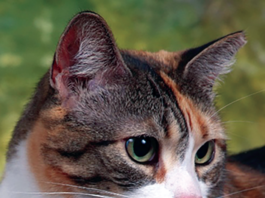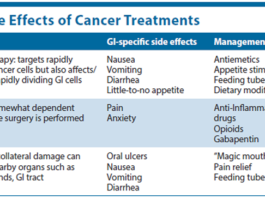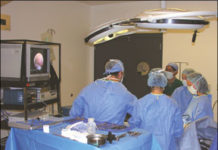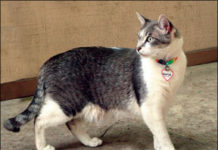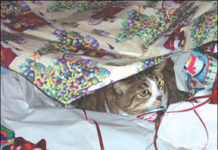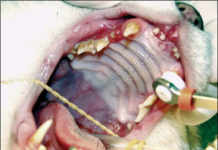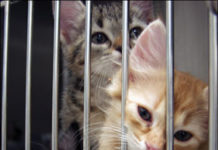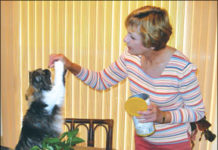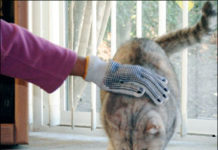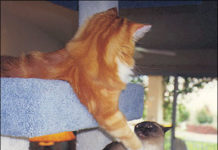Laparascopic Surgery
Your normally active cat isnt eating well, and shes suffering from intermittent vomiting and diarrhea. You make an appointment at the veterinary clinic and during the exam, your veterinarian recommends a liver biopsy to determine exactly whats going on. Sounds simple enough, but taking a biopsy requires that your cat be placed under general anesthesia and her abdomen cut open so the veterinarian can take a small sample of the liver. Afterward, the wound is sutured and your cat must remain in the hospital for a day or two for observation, all the while receiving medication to alleviate her post-operative pain. In the past, this was the typical scenario for all exploratory surgeries in the abdominal region of a cats body. Today, with advances in veterinary medicine, veterinarians have access to a revolutionary surgical technique called laparoscopy - a minimally invasive medical procedure that is being used with increasing frequency for a variety of diagnostic and surgical purposes. The technology is a giant step forward for the veterinary surgical field, according to James Flanders, DVM, an associate professor of surgery at Cornell Universitys College of Veterinary Medicine. "Traditionally, veterinarians would perform an open surgery, where we make a large, mid-line incision in the abdomen in order to look inside and do whatever we need to do, whether its to take a biopsy of the liver or to remove bladder stones. Now, with the laparoscope, we only need to a few small incisions (each one about a half-inch in length). Because the incisions are so tiny, the animal experiences far less post-operative pain and recovers faster."
Upper Respiratory Disease
Indications that your cat is experiencing a viral infection of its upper respiratory tract - which includes its nose, sinuses, pharynx and larynx - are similar to those that trouble you when you catch a cold: watery eyes, runny nose, wheezing, sneezing and coughing. Just as you are likely to be completely and permanently rid of your cold within a week or so, a cat, in most instances, will also get over the clinical signs of disease within a few days. In some cases, however, serious complications can occur. About 80 percent of feline upper respiratory infections are caused by either of two viruses: feline herpesvirus (FHV), also known as feline rhinotracheitis virus (FRV); and feline calicivirus (FCV). A third and far less frequent cause of upper respiratory infections in cats is Chlamydophilia felis, a bacterial agent. "All three of these organisms are very specific to cats," says Dr. Richard Goldstein, an associate professor of small animal medicine at Cornell Universitys College of Veterinary Medicine. None of these disease agents, he notes, is transmissible to humans or dogs.
No Kitty Left Behind: Operation Baghdad Pups
Operation Baghdad Pups, an SPCA International initiative, helps Americans serving in Iraq bring home the animals theyve befriended while on duty. Though at first glance, it might appear that Operation Baghdad Pups is limited to canines, roughly ten percent of the pets in the program are cats. The first cat to come "home" to the states through the program was a small, calico kitten that had been hiding in a trucks engine compartment. Bruce, an American contractor working in Northern Iraq, estimates the kitten was riding in the engine for more than 30 km before she jumped out from under the hood. Alarmed by the kittens serious injuries to one of her front legs, Bruce and a security medic liaison officer treated her "in the field." When she didnt improve after a few days, Bruce took the kitten to the site emergency medical doctor, who gave her further medical treatment. Bruce relates that in an environment in which he had little social contact and spent every waking hour installing "important basic infrastructure" to the local people in Northern Iraq, the little kitten "Hope" filled a void in his life. When the kitten was well enough to venture outside, she quickly befriended the rest of the camp and became a well-loved, affectionate mascot. The day came, of course, when it was time for Bruce to head home; however, he couldnt bear the thought of leaving "Hope" behind. She lacked all survival skills of a feral cat, he explains, and with the emotional attachment he had made during the six months the two had been together, "It would be like me abandoning my own child."
Cat Collars for Safety
As a human companion concerned about your feline, your question should not be if your cat needs a collar - but what type of collar your cat needs. All cats need a collar and an ID tag. That may come as a surprise to you if you keep your cat indoors. But many lost cats were indoor cats at the time they went missing. "Almost half the people who have lost a cat never expected their indoor-only cat to get outside," says Brenda Griffin, DVM, MS, with the Department of Population Medicine and Diagnostic Sciences of Cornell University's College of Veterinary Medicine. Indoor cats get frightened and bolt out of the house, a guest leaves the door open accidentally, your family must vacate the house in an emergency or natural disaster. Anything can happen. An indoor cat that finds itself outside is particularly vulnerable to getting lost and becoming a stray because its not used to being outdoors and finding its way home. Whatever scared your cat in the first place may cause your cat to stay in hiding, not come home or prevent you from finding it. "We strongly encourage people to collar their cats - even if theyre strictly indoor cats," says Brenda Griffin, the veterinarian in charge of initiatives to promote pet ID for both cats and dogs at Cornell University. "We consider an ID collar an essential component of a wellness program for all pet cats (wellness equals preventive medicine)." Outdoor cats are as easily lost. People may think a cat doesnt belong to anyone and may take the cat away from the area. A collar immediately signifies that a cat has a home. If the unthinkable happens and your cat - indoor or outdoor - gets lost, the chances of your cat being found and returned to you are infinitely higher if your cat is wearing some form of ID.
Disaster Help: In the Wake of Hurricane Ike
As a result of Hurricane Ike, the Houston SPCA rescued more than 1800 animals; fed/watered 500 animals that were left in their homes by evacuating families; placed more than 450 pets in temporary foster homes, and celebrated nearly 400 miraculous reunions. Prior to Hurricane Ike making landfall, the Houston SPCA worked in concert with other area shelters: Dogs and cats were relocated from the Houston SPCA to shelters in outlying areas, so that dogs and cats from coastal shelters in danger of destruction could be moved to safety in Houston. In addition, the Houston SPCA coordinated evacuation efforts for owners in need of crates, carriers, muzzles, leashes and other travel items necessary to safely evacuate their beloved pets with them to shelters, hotels and other temporary living arrangements. The question remains, of course, why were so many pets left behind when owners had more than a week to prepare a safe evacuation? Under the Pets Evacuation and Transportation Standards (PETS) Act of 2006, state and local emergency preparedness authorities were required to accommodate households with pets or service animals in their evacuation plans. "The common reasons we heard [for leaving pets behind] were, We didnt think wed be gone so long, We left food on the table, or theyd say, We thought theyd be fine," relates Meera Nandlal, public relations manager for the Houston SPCA in Houston, Texas.
The Danger of String
Brooke Remy of Boston, MA, was delighted to watch her cat Puddles play with a long, pink ribbon she had just taken off a gift box. He twirled around and around and rolled over on the floor. Brooke tired before Puddles did, and left the room for about five minutes. When she returned, the ribbon was gone - except for about two inches sticking out of Puddless mouth. He was coughing and drooling. Running over to him, Brooke began slowly pulling the ribbon out of his mouth, watching in terror and amazement as she removed eight inches of wet pink ribbon from his throat. Puddles was lucky that Brooke had returned in time. If he had swallowed the ribbon without Brookes quick intervention, he could have suffered very serious, even life-threatening, damage to his intestinal tract.
Feline Dental Disease
It may surprise you to learn that dental disease is the most common disease in cats. In fact, approximately 50 percent of all cats show signs of gum and teeth problems by the time they reach adulthood. What is dental disease and what can you do to prevent it from happening to your cat? Periodontal disease - which includes gingivitis and periodontitis - is a serious condition that, when left untreated, can lead to tooth loss and may even cause damage to vital organs because bacteria from the mouth can circulate through the bloodstream. Gingivitis is an inflammation of the gums that is caused when plaque bacteria accumulate on the tooth surface and in small pockets at the gumline called the gingival sulcus. According to Daniel Carmichael, DVM, a veterinary dentist at the Veterinary Medical Center in Islip, New York, "The gum tissue or gingiva senses the bacterial plaque, which causes the capillaries to dilate and bring in white blood cells, thus making the gums red, swollen and prone to bleeding."
Foster a Kitten: And Save a Life
Consider this: One cat and her offspring can produce a whopping 420,000 cats in just seven years. Yikes, thats a lot of cats. Each year, from April to November, hundreds of thousands of kittens are born - often to feral or stray moms that eke out a meager existence on our city streets, in the suburbs and in rural areas across America. Without human intervention, most of these newborns will die or, at best, lead short, miserable lives. The moms that are not killed by cars, other animals or disease, will repeatedly become pregnant, adding to the already crushing pet overpopulation problem. Aside from ensuring that your own cats are spayed and neutered, consider fostering a litter of homeless kittens. Sadly, many animal shelters dont have the staff or resources available to care for kittens that are ill or too young for adoption. Newborn kittens that have lost their mom must be bottle-fed around the clock and their tiny bladders and bowels must be expressed on a regular basis. Animal shelters that have kitten foster programs in place need dedicated people who are willing to welcome kittens into their home and nurture them until they are old enough to be placed for adoption.
Treats: Don’t Overdo It!
A fine way to show your deserving cat that youre a wonderful human being is to give her a delicious treat now and then - a scrap of baked salmon, for example, or a tiny slice of chicken from your dinner plate. Or perhaps youll unwrap a new pack of its favorite commercial snack - a chewy chicken-flavored tidbit that you discovered on the shelves of your local grocery store. This give-and-take interaction with your cat is perfectly all right, says Francis Kallfelz, DVM, a professor of veterinary nutrition at Cornell Universitys College of Veterinary Medicine, as long as you practice it in moderation and with appropriate vigilance. "The main reason that cat owners give treats is to enhance the human-animal bond," he says, "and there is nothing inherently wrong with that. In fact, theres a good chance that offering treats now and then will make your cat more responsive to you." He points out, however, that any treat should be considered a component of a cats overall daily diet and that, of course, it should be a substance that is safe for feline ingestion. Also, he advises, "Be sure that your cat doesnt become so addicted to treats that it starts refusing to eat its regular food."
Cleaning Secrets to Try
With three shorthaired and five longhaired cats, Debbie Salerno, chairperson of the board for Maine Coon Cat Rescue in Hazlet, NJ, knows all about cat hair. "I find hair on the steps, on the carpeted cat tree, in the carpet in the hallway, wafting across the floor, and settled into the corners [of rooms] and around the bottom of the furniture," she relates. When hair is not cleaned up, it tends to travel with Salerno to work: "The hair gets all over the furniture and then sticks to me, and it winds up in my car and sometimes in my office if I dont get it off." Admittedly, for some cat owners, wayward hair is not a big issue. For other owners, however, it is. "Cleanliness is a high priority for me," explains Bobbie Williams of Beavercreek, OH. Williams, a volunteer for Maine Coon Rescue, will be hosting a wedding in her home soon and has the hair of four cats (two longhaired and two short-haired) to contend with for this event.
Cat Fights: What to Do?
While fighting among cats is not typical behavior, it does happen. Read on to learn some reasons why cats pick fights with each other - and what you can do about it. All kittens play, practicing to defend themselves by arching their backs, jumping on each other, chasing each other and maybe exchanging a few nips on the ears. "The difference between playing and fighting," says Katherine A. Houpt, VMD, the James Law Professor of Animal Behavior, Cornell Universitys College of Veterinary Medicine, "is that when playing, cats take turns chasing each other. There isnt one dominant aggressor or one main victim. Nobody hides." In general, cats dont play much after 16 months of age, and males are more likely to engage in play of this kind. As for fighting, cats will fight at any age. "True fighting is usually more of a one-way process," says Dr. Houpt. "One cat will be the aggressor and the other will be the victim. Hissing, clawing and batting with the paws are more fear-directed than playful. The noisier the interaction, the more likely its a fight and not play."
The Rising Cost of Pet Food
Its no secret that gas prices are on the rise. So is just about everything else, including pet food. The U.S. Bureau of Labors Consumer Price Index reports that pet food prices for the second quarter of 2008 rose by eight to nine percent. While thats not as much of an increase as milk or gasoline, consumers are still seeing the most significant price increase in pet food in years. What gives?"If you look at the rising cost of pet foods, its all because of the cost of grains," says Joseph Wakshlag, DVM, PhD, assistant professor of Clinical Nutrition at Cornell Universitys College of Veterinary Medicine. "All of the grains such as corn and rice that are used to make pet food have gone up in price, so pet food prices had to rise as well. And that cost has to be passed on to the consumer." Pet owners like Teri Grohl have noticed. Grohl, an administrative assistant for a high-tech company, spent a portion of her $600 stimulus check on food and cat litter for her three cats, ages 12, six and two.



